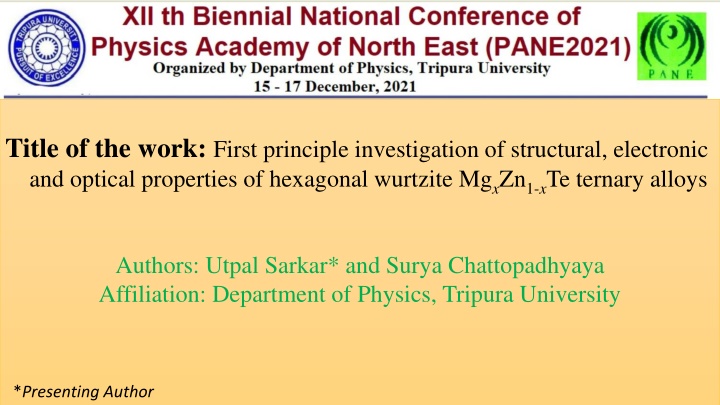
Investigation of MgxZn1-xTe Ternary Alloys' Optoelectronic Properties
Explore the structural, electronic, and optical properties of hexagonal wurtzite MgxZn1-xTe ternary alloys through theoretical studies using DFT-based FP-LAPW approach. The research focuses on different Mg concentrations and the impact on lattice parameters, bulk modulus, band structure, and dielectric constant. This study contributes to the understanding of II-VI compound semiconductor technology for various applications like optical detectors, solar cells, and light-emitting devices.
Download Presentation

Please find below an Image/Link to download the presentation.
The content on the website is provided AS IS for your information and personal use only. It may not be sold, licensed, or shared on other websites without obtaining consent from the author. If you encounter any issues during the download, it is possible that the publisher has removed the file from their server.
You are allowed to download the files provided on this website for personal or commercial use, subject to the condition that they are used lawfully. All files are the property of their respective owners.
The content on the website is provided AS IS for your information and personal use only. It may not be sold, licensed, or shared on other websites without obtaining consent from the author.
E N D
Presentation Transcript
Title of the work: First principle investigation of structural, electronic and optical properties of hexagonal wurtzite MgxZn1-xTe ternary alloys Authors: Utpal Sarkar* and Surya Chattopadhyaya Affiliation: Department of Physics, Tripura University *Presenting Author
Introduction Last several decades semiconductor technology of type II-VI compounds has gradually progress in fabricating optical detectors, photoconductors and light sources. The wurtzite (B4) phases of transition metal chalcogenides are very useful compounds in this category. Direct and wide band gap II VI semiconductors drawn significant interest because of their use in electroluminescent devices, solar cells, light emitting devices and laser diodes. The theoretical and experimental studies of structural and optoelectronic properties of such materials have attracted more attention in the recent year. For that reason, we have performed the theoretical studies of optoelectronic properties of MgxZn1-xTe ternary alloys in their hexagonal wurtzite phase at different Mg-concentrations using DFT based FP-LAPW approach.
Unit cell Structures of the compounds in Wurtzite (B4) Phase (a) ZnTe (d) Mg0.75Zn0.25Te (c) Mg0.50Zn0.50Te (e) MgTe (b) Mg0.25Zn0.75Te Fig.1: Unit cell Structures of binary and ternary compounds
Structural Property 52 Compound ZnTe a0 ( ) 4.280 4.320(expt.) c( ) 7.0363 7.10(expt.) B0(GPa) 50.793 (c) 48 B0 (GPa) 44 40 Mg0.25Zn0.75Te 4.3477 7.1476 45.783 36 (b) 7.4 7.3 4.4153 7.2588 41.217 Mg0.50Zn0.50Te c ( ) 7.2 7.1 7.3671 Mg0.75Zn0.25Te 4.4812 38.540 7.0 (a) 4.5 a ( ) 7.4700 7.3916 (expt.) 4.4 MgTe 4.5438 4.550(expt.) 36.271 4.3 4.2 0.00 0.25 0.50 0.75 1.00 Mg-Concentration(x) Table 1:Calculated structural parameters of binary compounds and ternary alloys under the MgxZn1-xTe systems in wurtzite phase. Fig.2: Variation of lattice parameters and bulk modulus and with Mg-doping concentration.
Electronic Property Optical Property 15 16 x=1.0 xx x=1.0 xx 12 10 zz zz 8 4 5 0 0 -4 x=0.75 x=0.75 12 12 9 8 6 4 3 0 0 -4 x=0.50 x=0.50 12 10 8 1( ) ( ) 4 5 0 0 -4 x=0.25 x=0.25 12 10 8 4 5 0 0 -4 x=0.0 x=0.0 12 10 8 5 4 0 0 -4 0 6 12 18 24 30 0 6 12 18 24 30 Energy (eV) Fig.3: Band structure of Mg0.25Zn0.75Te ternary alloys in TB-mBJ potentials Energy (eV) Fig.4: Variation of Real and Imaginary part of the dielectric constant.
References Conclusions 1] P. Hohenberg, W. Kohn, Phys. Rev. B 136 (1964) 864-871. [2] F. Tran, P. Blaha, Phys. Rev. Letts. 102 (2009) 226401-226404. [3]. H. C. Ong, J. Y. Dai, Appl. Phys. Letts. 81 (2002) 8. [4] L. Tairi, S. Touam, A. Boumaza, M. Boukhtouta, H. Meradji, S. Ghemid, S. B. Omran, F. E. Haj Hassan & R. Khenata, Phase Transitions, 2017 [5] S. Desgreniers, L. Beanlieu, Phys. Rev. B 61(2000) 13. [6] H. Mittendorf, Z. Phys.183 (1965) 113-129 [7] S.Q. Wang, H.Q. Ye, Phys. Rev. B 66 (2002) 235111-235118 The lattice constants (a0 and c) slightly increase with the doping concentration while the bulk modulus (B0) decreases with the doping concentration. All the binary compounds and ternary alloys are wide and direct band gap ( ) semiconductors . In the real and imaginary part of dielectric constants graphs for different doping concentration, the characteristic peaks in all the curves appear mainly due to transitions of electrons from valance band to conduction band.
